

#Babacad lisp entmake code#
Using argument names in the OP's code in Message 1: Today’s post assumes you’re no longer a beginner, but not an expert yet.

In part one of our series, we talked about some of the basics you should know when beginning with AutoLISP and what kinds of things you can automate with that knowledge. You may do it in the native AutoLISP way, with ENTGET, ENTMAKE, SUBST etc., or you may have learned to convert it to a Visual LISP object with VLAX-ENAME>VLA-OBJECT, access its properties, and use its methods, such as GET and PUT. AutoLISP to Automate Your Tasks: Part 2 Intermediate. This is all that's needed - the Text command handles all the rest of those complications, so you don't have to account for their possibilities. You’re good at getting entities, so you’re probably good at manipulating them as well. And sometimes the 11 code is the insertion point and the 10 code is '(0 0 0).Īnd you wonder why I like to use the (command) function. Sometimes it needs more data and sometimes less. I've compared it to other entmake text commands I've found and it's very similar, so I just don't know why it wont work. It doesn't tell me where it goes wrong, just nil. When I use it, though, it just returns nil. (cons 73 verJust) Vertical text justification, 0=Baseline,1=Bottom,2=Middle,3=Top

(cons 72 horJust) Horizontal text justification,0=Left,1=Center,2=Right,4=Center,5=Fit (cons 71 0) Flags 0=Normal, 2=Backward, 4=Upside down (cons 1 txtString) Default value (the string itself) (cons 11 insertPt) Second alignment point These values are just being used for testing This is my function: (defun CreateText (txtStyle txtJust insertPt txtString) It's just that in ACad it's generally easier to start such a thing in AutoLisp (not as much preliminary work and learning to do as you'd need when making your tools in C++/C#).I've looked all over and have tried different versions of the Entmake text command, but I can't get mine to work. as an ObjectARX extension written in C++, or a DotNet assembly written in C#, or some older stuff as VBA macros. It may equally be written in something else, e.g. like Lee Mac's Increment Suite, or the AutoIncr tool in one of my old tools: Caddons ). That example may very well be an AutoLisp tool someone wrote (i.e. Others (both older and more recent) include: Common Lisp / Scheme / Clojure / Racket / Julia / etc. Since then many different implementations were created, AutoLisp derived from one called XLisp which was made in the mid 70s. You get other Lisps as well (though not of much use inside of ACad), LISP was originally one of the very first programming languages, in fact it's the 2nd high-level language just after Fortran (originally made in 1958 ). This works as an interpreted scripting language (much like JavaScript works inside of web pages). Inside AutoCAD there's a variant of LISP called AutoLisp. Was what I witnessed a lisp?LISP is a programming language. The number size varied to paper scale size. Years ago I witnessed a person working on autocad and he was placing numbers within a circle just by clicking the mouse. Please let me know and move if it needs to be. (setq chrnum (ascii (substr ptnum 1 1))) 1st character is number (setq ptnum (getstring "\nEnter Pt Number or alpha")) Completion of a block definition ( entmake of an endblk) returns the block's. If entmake is unable to create the entity, it returns nil. If successful, entmake returns the entity's list of definition data. Even when I use the next code AND set OSMODE to 0 it puts the ATTDEF (0,0) I tried to use the same order as in one of my other lisp-files. If the elist contains an entity handle, entmake ignores that too. (defun C:bub (/ ptnum ptnumb pt pt2 oldsnap chrnum sc curspace) The entmake function ignores the entity name when creating the new entity. (mapcar '(lambda (pt) (cons 10 pt)) vertexList)


 0 kommentar(er)
0 kommentar(er)
